
Having been born in 1924, I grew up during the time of the Great Depression of the 30's. These are some of my recollections of that time.
Following the happy-go-lucky era of the 1920's,the United States was now in the throes of the"Great Depression" caused by the stock market crash of 1929. Banks had failed, wiping out the savings of millions of people. The jobless were counted in the millions.A popular song of that time, "Brother Can You Spare a Dime?" symbolized the despair of the unemployed.
Made it race against time;
Once I built a railroad, now it's done,
Brother can you spare a dime....?
Soup kitchens and bread lines were set up to feed the
 hungry. Countless numbers of people were forced to live on the streets of every major city. Cardboard boxes and makeshift tents formed little cities, within cities.
hungry. Countless numbers of people were forced to live on the streets of every major city. Cardboard boxes and makeshift tents formed little cities, within cities. With the election of President Franklin Delano Roosevelt in
 1932, the first signs of better times to come became apparent. "We have nothing to fear, but fear itself", he told the nation. He inaugurated a program of regular radio speeches, known as "fireside chats", that kept the public apprisedof the progress being made by the administration.The soothing, pleasant tone of his voice held youcaptive. The "chats" raised your spirits.
1932, the first signs of better times to come became apparent. "We have nothing to fear, but fear itself", he told the nation. He inaugurated a program of regular radio speeches, known as "fireside chats", that kept the public apprisedof the progress being made by the administration.The soothing, pleasant tone of his voice held youcaptive. The "chats" raised your spirits. His program was called the New Deal, and immediately in 1933 the National Recovery
His program was called the New Deal, and immediately in 1933 the National Recovery  Act, known as the N.R.A., came into being.This Blue Eagle emblem was being displayed in all public places, and on manufactured items. The public were proud to show their participation in this program.
Act, known as the N.R.A., came into being.This Blue Eagle emblem was being displayed in all public places, and on manufactured items. The public were proud to show their participation in this program.People were put to work on government projects. The
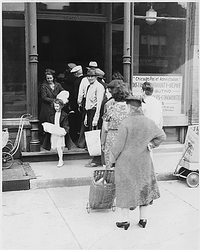 depression was still affecting most people, A welfare program known as "home relief", supplied free foods to the poor. but signs of better times to come were on the horizon.
depression was still affecting most people, A welfare program known as "home relief", supplied free foods to the poor. but signs of better times to come were on the horizon.By 1935, America was on its way to recovery. More people were returning to work, albeit salaries were very small. A new phrase was introduced, "Social Security". Congress
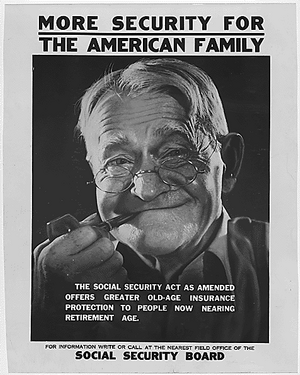 enacted a new law that would enable those over 65 years of age to retire with a government paid income, depending on the number of years the person worked, and the amount of their total earnings.This program was manditory. Happy Days are here Again was becoming the new byword.
enacted a new law that would enable those over 65 years of age to retire with a government paid income, depending on the number of years the person worked, and the amount of their total earnings.This program was manditory. Happy Days are here Again was becoming the new byword.Though money was still tight, nickels and dimes had great purchasing power. Woolworth's and other such stores were known as "5 and 10's". Five cents was the fare for the subway. You could go from one end of the city to the other, for that nickel.
Sometimes, during the summer, a Saturday night date would be a ride on the Staten Island ferry.This 45 minute trip from Brooklyn or Manhattan, to Staten Island, cost 5 cents per person. The boat people usually didn't charge for the return trip. We often made several round trips, for that nickel we had paid. Going with other dating couples was a great way to spend the evening.
Saturday night dates were at the Roxy, Radio City Music Hall, Strand, or any of the other big movie houses in Times Square. Dinner at Tofenetti's, a movie, and afterwards, coffee and Strawberry Shortcake at Lindy's, what a date!
How about going swimming, in the pool at the St. George hotel, in Brooklyn?
At Coney Island, for 50 cents you could purchase a ticket at Steeplechase, entitling you to 35 rides in this amusement park. Before the day was over, you found yourself walking in circles!
A major attraction at Coney was the Wonder Wheel.
 At a height of 150 feet, it was the world's tallest ferris wheel. It had cages that would roll forward as the wheel would be going downward which made you think the cage was falling off. We guys would shake the cage, just to make the girlsscream!
At a height of 150 feet, it was the world's tallest ferris wheel. It had cages that would roll forward as the wheel would be going downward which made you think the cage was falling off. We guys would shake the cage, just to make the girlsscream! A swim in the ocean, a stroll on the boardwalk, play some games, go on some rides, and finally a hotdog, french fries, and a mug of root beer at Nathan's, (only 5 cents for each item) made for a great day!
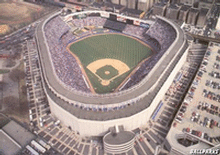 There were 3 major league ball parks in New York. The Yankee Stadium in the Bronx, was the home of the N.Y. Yankees.
There were 3 major league ball parks in New York. The Yankee Stadium in the Bronx, was the home of the N.Y. Yankees.Ebbets Field in Brookyn, was the home of the Brooklyn Dodgers, (affectionately known as "Dem Bums"). The Polo Grounds in Manhattan, was home to the N.Y. Giants. At any of these ballparks theadmission price for the bleacher seats was 55 cents.
At New York's sport palace, Madison Square Garden, we were able to go to see Basketball, and Ice Hockey games. Prices for students were reduced, if you showed your school General Organization (G.O.) card.
The "Garden" also hosted Boxing, Wrestling, the Barnum and Bailey Circus, and the Rodeo.
| ~ Movie Posters of the 30's ~ | |||||
 | 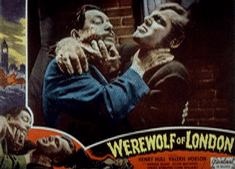 |  | |||
 |  |  | |||
 |  | 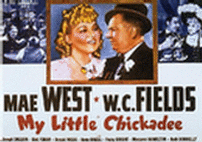 | |||
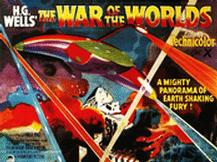 |  | 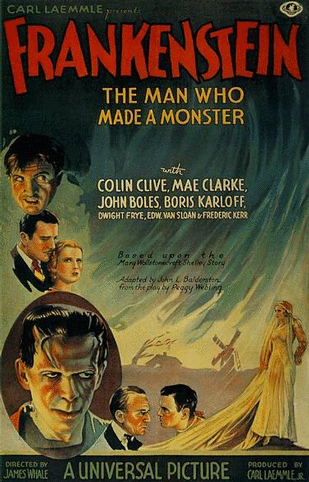 | |||
Movies enabled us to escape from the reality of the hardships of the time. For 3 hours, we were able to transport ourselves to another dimension. If it was a musical, you came away with a song on your lips, forgetting all else, temporarily. We guys favored westerns, or "cowboy pitchers" as wecalled them. When it was time to leave, we rode our imaginary horse out of the theater, and all the way home. Love "pitchers" were not for boys.we preferred mysteries and horror. The bigger the monster, the better.
For ten cents we were able to go to a movie and see a 3 hour show, consisting of two full length pictures, a cartoon, newsreel,coming attractions of future films, and a chapter of the current serial. With a brown paper bag, full of sandwiches and fruit to sustain us, we kids sat through at least 2 showings of the entire program, or until they threw us out!
Movie theaters in the Times Square area (42nd street and Broadway), showed the latest films, and also had live entertainment starring one of the "Big Bands". Admission to the Paramount theater, was 25 cents before 1 p.m., and 55 cents after that time. Evening prices were much higher.Many were the classes I cut, to get there before1 p.m.
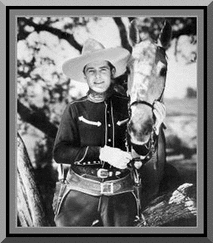 | My Favorite Cowboy...Ken Maynard |
| My Favorite Tarzan...Johnny Weissmuller |  |
 | My Favorite Monster...Boris Karloff |
In our streets during warm weather periods, we played stickball (how many sewers could you hit?) and punchball, using a pink Spaulding rubber ball, or "Spauldeen" as we called it. There was also johnny-on-a-pony, tag, stoop ball, kick the can, ring-a-leevio (?), and many other games.
On hot summer days we would go swimming at Coney Island, Orchard Beach, the East River, or in the Hudson, if you lived on the west side. During heat spells people slept on their fire escapes, in parks, or on their apartment house roof. ("tar beach", as we jokingly referred to it.)
Let's not forget the education we received at the "English Academy", better known as the Poolroom,where we played Chicago, Rotation, and Blackball.The price was 5 cents per game. If you could afford it, you "shot" regular pool (billiards) at60 cents per hour.
In the cooler times we played touch football, better known as "Association". When there was snow, we built forts on opposite sides of the street, and engaged in a battle of snowballs, and also "belly whopped" on our sleds.
Girls preferred jumping rope, (remember Double Dutch?) jacks, potzey, and a game played by turning a leg over a bouncing ball while reciting...."A my name is Anna, and my husband's name is Al"........Or, while bouncing a ball, they would sing-song, "1-2-3 O'lary, my sister's name is Mary".......
Not having much money to spend, made us quite innovative. With a four foot length of 2x4, a wooden orange crate, and one roller skate (a halfat each end of the 2x4, we made a scooter, One foot did all the work, and that shoe always developed a floppy sole. I can still hear my father's voice...."How the hell do you wear out only one shoe!"
If we were lucky enough to find an old carriage, the four wheels and two axles enabled us to build a "pushmobile". We made rubber band guns from the dovetail joint of orange crates, that would shoot squares of cardboard or linoleum.
Two tin cans and a waxed length of cord, made an excellent telephone.
At school, one day a week was reserved for "Assembly". Girls wore middy blouses and blueties, while boys wore white shirts and blue ties.Being the Eraser Monitor was a desirable assignment, it gave us a chance to leave the classroom for a few minutes, to go outside and clean the blackboard erasers.
Dreaded words....Report Card,...Principal's Office,...Bring your father to school!
Growing up in N.Y. during the 1930's was to some extent, the worst of times, and yet, I believe in some ways it was the best of times.
